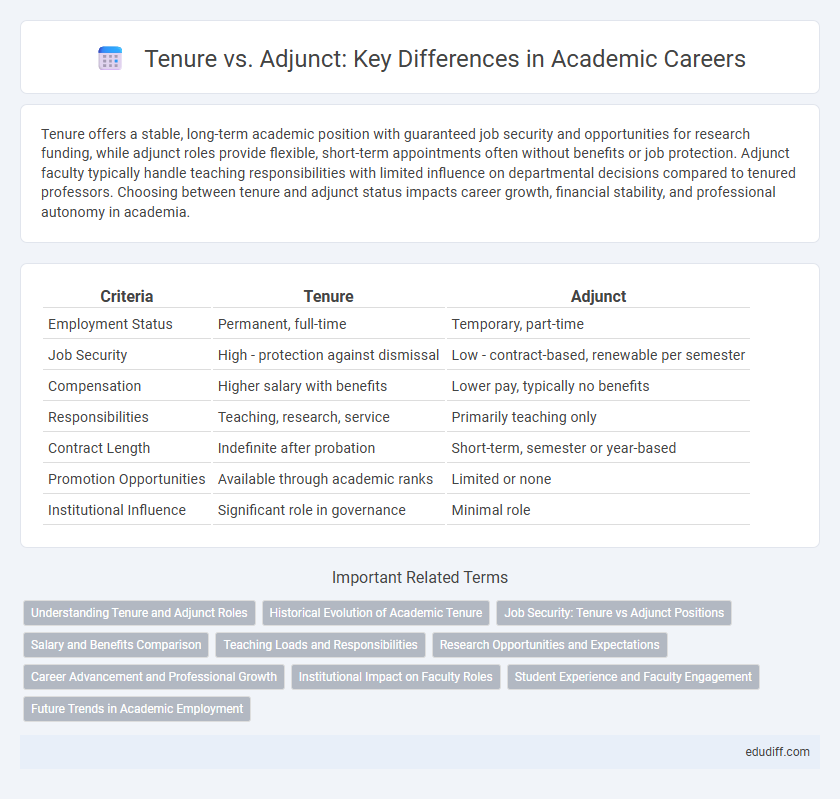Tenure offers a stable, long-term academic position with guaranteed job security and opportunities for research funding, while adjunct roles provide flexible, short-term appointments often without benefits or job protection. Adjunct faculty typically handle teaching responsibilities with limited influence on departmental decisions compared to tenured professors. Choosing between tenure and adjunct status impacts career growth, financial stability, and professional autonomy in academia.
Table of Comparison
| Criteria | Tenure | Adjunct |
|---|---|---|
| Employment Status | Permanent, full-time | Temporary, part-time |
| Job Security | High - protection against dismissal | Low - contract-based, renewable per semester |
| Compensation | Higher salary with benefits | Lower pay, typically no benefits |
| Responsibilities | Teaching, research, service | Primarily teaching only |
| Contract Length | Indefinite after probation | Short-term, semester or year-based |
| Promotion Opportunities | Available through academic ranks | Limited or none |
| Institutional Influence | Significant role in governance | Minimal role |
Understanding Tenure and Adjunct Roles
Tenure offers professors long-term job security and academic freedom after a rigorous evaluation process, ensuring stability and influence in university governance. Adjunct roles are typically part-time or contract-based positions with limited job security, often paid per course without benefits or voting rights in faculty decisions. Understanding these distinctions clarifies how tenure supports career advancement and institutional commitment, whereas adjunct positions provide flexible, temporary teaching resources.
Historical Evolution of Academic Tenure
The historical evolution of academic tenure dates back to the early 20th century when universities introduced tenure to protect faculty from arbitrary dismissal and promote academic freedom. Originally established through formal agreements in the 1940s and 1950s, tenure distinguished permanent, full-time professors from adjuncts who occupied contingent, non-tenure-track positions with limited job security. Over time, the tenure system has faced challenges due to increasing reliance on adjunct faculty for cost efficiency and institutional flexibility.
Job Security: Tenure vs Adjunct Positions
Tenure offers long-term job security with protection against arbitrary dismissal, ensuring academic freedom and stable career progression for professors. Adjunct positions lack these protections, often relying on short-term contracts with limited benefits and a high risk of non-renewal. The disparity in job security between tenure-track and adjunct roles significantly impacts faculty retention and institutional commitment.
Salary and Benefits Comparison
Tenure-track professors typically receive higher salaries and comprehensive benefits packages, including health insurance, retirement plans, and paid leave, compared to adjunct faculty who often work on a per-course basis with limited or no benefits. Adjuncts face lower job security and fewer financial incentives, with compensation frequently below the national average for full-time academics. Institutions invest more in tenured faculty due to long-term commitments, reflecting disparities in salary and benefits between these employment categories.
Teaching Loads and Responsibilities
Tenured professors typically handle balanced teaching loads combined with research, service, and administrative duties, often teaching three to four courses per semester. Adjunct faculty focus primarily on teaching, with heavier course loads ranging from three to six classes but limited responsibilities beyond classroom instruction. This distinction impacts workload, with tenured faculty engaged in broader institutional roles and adjuncts primarily committed to course delivery.
Research Opportunities and Expectations
Tenure-track faculty typically receive greater research support, funding opportunities, and institutional resources compared to adjuncts, enabling sustained scholarly productivity. Adjunct positions often lack formal research expectations, limiting access to research grants and professional development aimed at advancing academic inquiry. Research output and innovation are central to tenure evaluations, whereas adjunct roles prioritize teaching and lack structured incentives for research engagement.
Career Advancement and Professional Growth
Tenure offers long-term job security and opportunities for leadership roles, fostering sustained career advancement within academic institutions. Adjunct positions provide flexibility and diverse teaching experiences but often lack access to professional development resources crucial for growth. Securing tenure significantly enhances prospects for research funding, collaboration, and academic influence, accelerating professional growth.
Institutional Impact on Faculty Roles
Tenure positions provide faculty with long-term job security, fostering deeper institutional commitment and sustained contributions to academic governance and curriculum development. Adjunct faculty, often employed on short-term contracts, face limited integration into institutional decision-making, which can affect their influence on academic policies and departmental initiatives. The institutional impact of these roles shapes faculty engagement, resource allocation, and the overall academic culture within universities.
Student Experience and Faculty Engagement
Tenure-track faculty often provide more consistent mentorship and long-term academic guidance, enriching the student experience through sustained engagement and research opportunities. Adjunct instructors bring practical, real-world expertise and flexibility but may face limited availability, which can impact student access and continuity. Faculty engagement tends to be deeper among tenured professors due to job security and institutional support, fostering a more collaborative and innovative learning environment.
Future Trends in Academic Employment
Future trends in academic employment indicate a gradual shift from traditional tenure-track positions toward increased reliance on adjunct faculty, driven by budget constraints and institutional flexibility needs. Advances in remote learning technologies are expanding opportunities for adjunct roles, allowing universities to tap into a wider talent pool globally. Despite the growth of adjunct positions, tenure remains critical for securing academic freedom and long-term research commitments.
Tenure vs Adjunct Infographic

 edudiff.com
edudiff.com